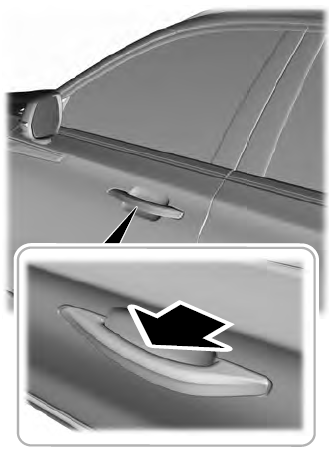Lincoln Aviator: Exterior Trim and Ornamentation / General Procedures - Finish Panel Repair
Repair
NOTE: Mouldings located on the front and rear window frames may experience minor scratches from vehicle shipment or car wash racks. The imperfections may be repaired instead of replacing components by following the steps below.
NOTE: Scratches deep enough to cause a thumb nail to catch cannot be repaired and the component must be replaced.
-
Clean with a mild soap and water wash, and dry the affected panels.
-
Apply protective masking to adjacent components.
-
Apply a small amount of clear coat and plastic
formulated polishing compound (obtain locally) to a 3 inch polisher with
an appropriate foam pad attached.
-
mostbet download
NOTE: Do not allow the polishing compound to dry while polishing the component.
Thoroughly polish the component.
-
Reclean with a mild soap and water wash and dry the polished panels.
-
If the scratches are repaired return the vehicle.
-
If the scratches remain, continue with the following steps.
-
If the scratches are repaired return the vehicle.
-
Choose a sandpaper grit appropriate to the scratch severity.
-
For very minor scratches, use a 3 inch 3000 grit sandpaper (obtain locally).
-
For minor scratches, use a 3 inch 1000 grit sandpaper (obtain locally).
-
For heavier scratches that do not catch a thumb nail
when pulled across the scratch, use a 3 inch 800 grit sandpaper (obtain
locally).
-
For scratches that are too deep to remove with 800 grit sandpaper, install a new component.
-
For very minor scratches, use a 3 inch 3000 grit sandpaper (obtain locally).
-
NOTICE: Do not remove any more material than necessary or component replacement will be required.
Apply the appropriate sandpaper to a 3 inch Dual Action (D/A) sander and carefully sand the component until all the damage has been removed.
-
Use progressively finer sandpaper with the 3 inch D/A
sander and repeat the process. Finish the sanding with 3000 grit
sandpaper.
-
Apply a small amount of clear coat and plastic
formulated rubbing compound (obtain locally) to a 3 inch polisher with
an appropriate foam pad attached.
-
NOTE: Do not allow the rubbing compound to dry while polishing the component.
Buff the component until the sanding scratches have been completely removed.
-
Apply a small amount of clear coat and plastic
formulated polishing compound (obtain locally) to a 3 inch polisher with
an appropriate clean foam pad attached.
-
NOTE: Do not allow the rubbing compound to dry while polishing the component.
Polish the component until the buffing swirl marks are removed.
-
Continue polishing the component until the original level of shine is present.
-
Apply a small amount of clear coat and plastic
formulated hand glaze (obtain locally) to a soft and clean shop cloth
and hand polish to remove swirl marks left by the 3 inch polisher.
 Removal and Installation - A-Pillar Moulding
Removal and Installation - A-Pillar Moulding
Special Tool(s) /
General Equipment
Interior Trim Remover
Removal
NOTICE:
Only use moderate force.
NOTE:
Removal steps in this procedure may contain installation details...
Other information:
Lincoln Aviator 2020-2025 Service Manual: Description and Operation - Body - Overview
Insulation WARNING: To prevent the risk of high-voltage shock, always follow precisely all warnings and service instructions, including instructions to depower the system. The high-voltage system utilizes approximately 300 volts DC, provided through high-voltage cables to its components and modules...
Lincoln Aviator 2020-2025 Service Manual: Description and Operation - Gasoline and Gasoline-Ethanol Fuel Systems Health and Safety Precautions
WARNING: Before working on or disconnecting any of the fuel tubes or fuel system components, relieve the fuel system pressure to prevent accidental spraying of fuel. Fuel in the fuel system remains under high pressure, even when the engine is not running...
Categories
- Manuals Home
- Lincoln Aviator Owners Manual
- Lincoln Aviator Service Manual
- Changing the Front Wiper Blades - Vehicles With: Heated Wiper Blades
- Configuring The Head Up Display
- Interior Lamps
- New on site
- Most important about car
Activating Intelligent Access
The intelligent access key must be within 3 ft (1 m) of the door or luggage compartment you intend to lock or unlock.
At a Door
Electronic door handles are on each door. Gently depress the switch inside the exterior door handle to unlock and open the door. An unlock symbol illuminates on the door window trim indicating your vehicle is unlocked.


